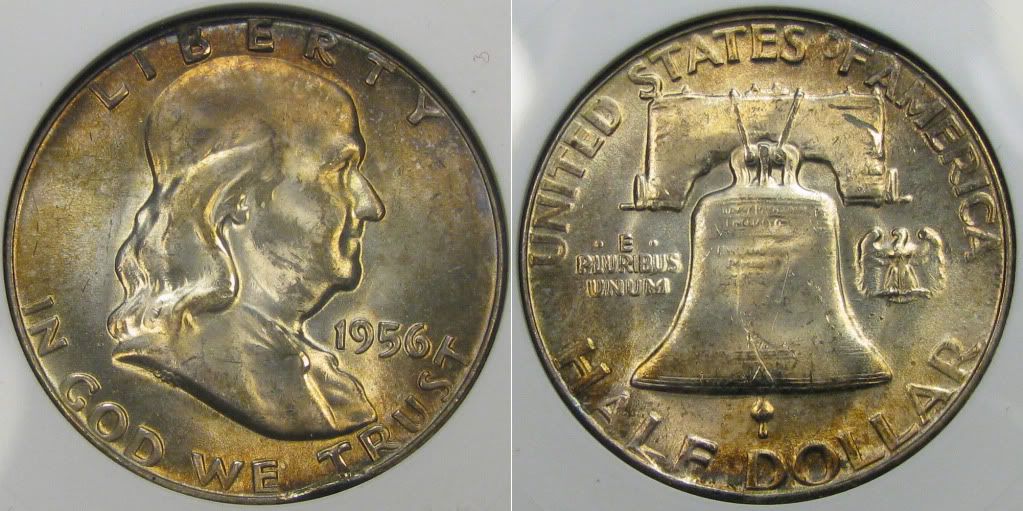
(An attractively toned 1956 incomplete planchet Franklin)
Error collectors divide errors into three broad categories: planchet errors, die errors, and strike errors. The incomplete planchet error, as can be guessed, is a type of planchet error. The actual error occurs when the blanks are being punched from the metal strip, near the beginning of the process. Sometimes, these errors can be quite dramatic, with a large percentage of the planchet missing. More often, only a small percentage is “clipped.”
As the metal strip is being fed into the blanking machine, a punch and cutter cut circular blanks out of the strip. After each punch, the strip is fed an incremental amount further into the machine. A normal strip, after blanking operations, looks like the strip on the left. However, sometimes the strip slips or gets stuck, and doesn’t move the full increment. For example, if the strip is fed at the wrong speed, the strip will not move far enough between punches. If this happens, the punch will then overlap the previously punched hole – and the resulting planchet will be incomplete. It will have a crescent missing with exactly the diameter of the punch (this detail will be important later).
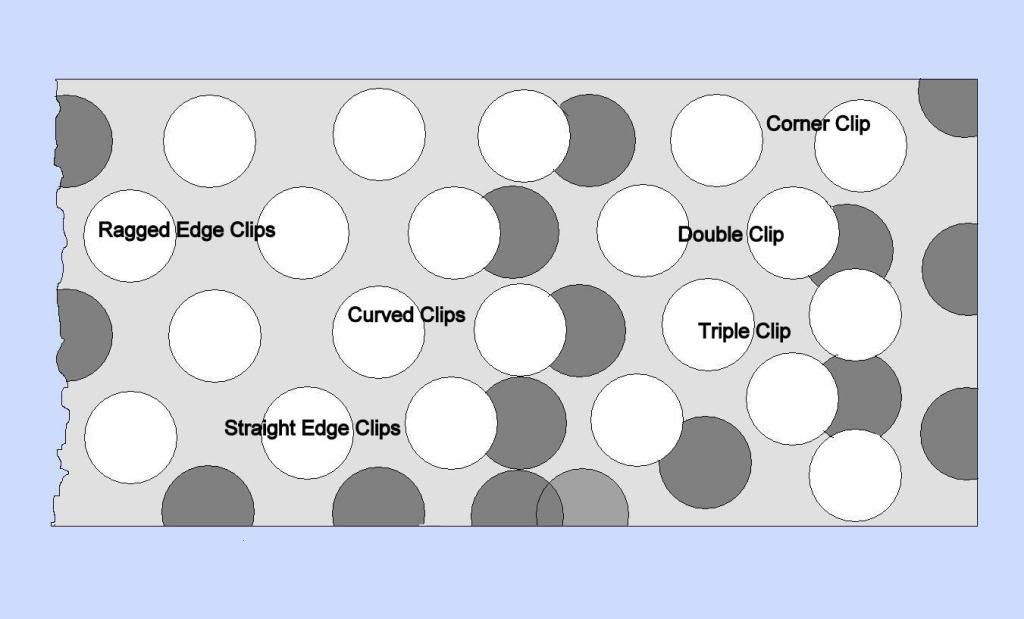
(Hypothetical metal strip, showing different kinds of incomplete planchet errors)
Besides the curved clip, there are a few other types of incomplete planchet errors which can occur, although all are generally lumped together and called “clips.” The above type, where the punches overlap each other, is widely known as a “curved clip,” and is by far the most common type of clip. The other two types are less common, and will thus usually garner a premium. The second type is when the metal strip is not aligned properly in the blanking press, and a punch overhangs the edge of the strip. The punch will create a blank with a “straight clip” at the edge. The third type of clip is known as a “ragged edge clip,” and is similar to the straight clip, but it happens at either end of the strip of metal where the strip is irregular and jagged. The 1963 Franklin clip below was labeled by ANACS as a straight clip, but I believe it to be the less common ragged clip, due to the irregular edge. A straight clip is, quite literally, very straight (with exceptions which shall be discussed below).
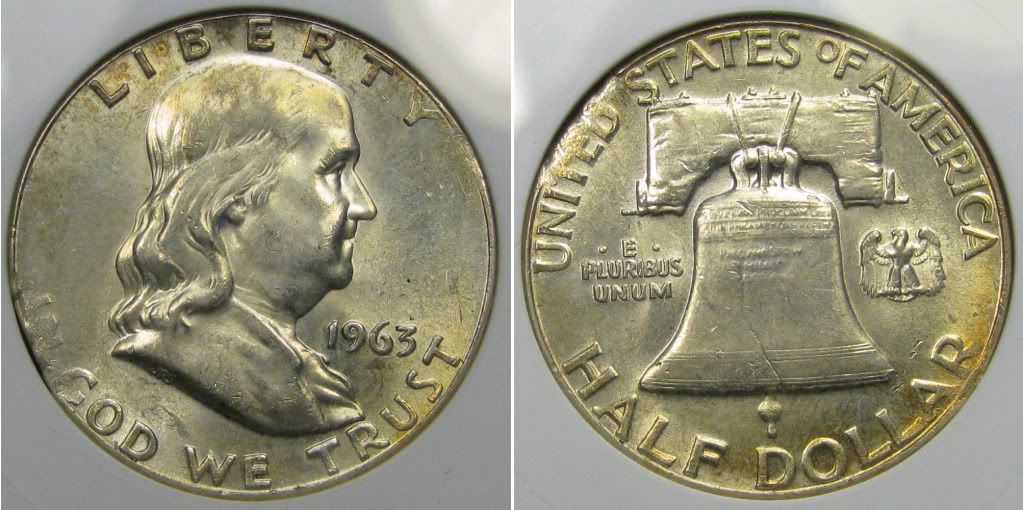
(1963 ragged edge clip Franklin)
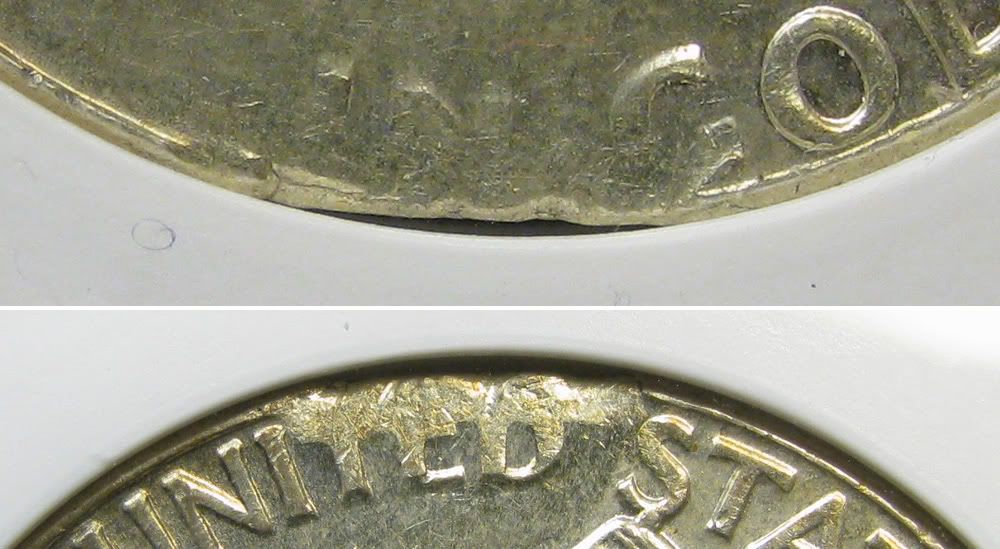
(Close-ups of the ragged edge clip)
Sometimes, the strip is improperly placed such that there is more than one “clip.” Just about any combination of clips you can imagine can occur: double curved clips, curved clip with straight edge clip, or even a corner clip which occurs when the blank is punched from the corner of the strip – and is quite rare. I only own one multiple clipped coin, the 1963D Franklin pictured below. The second clip is rather minor, but still cool!
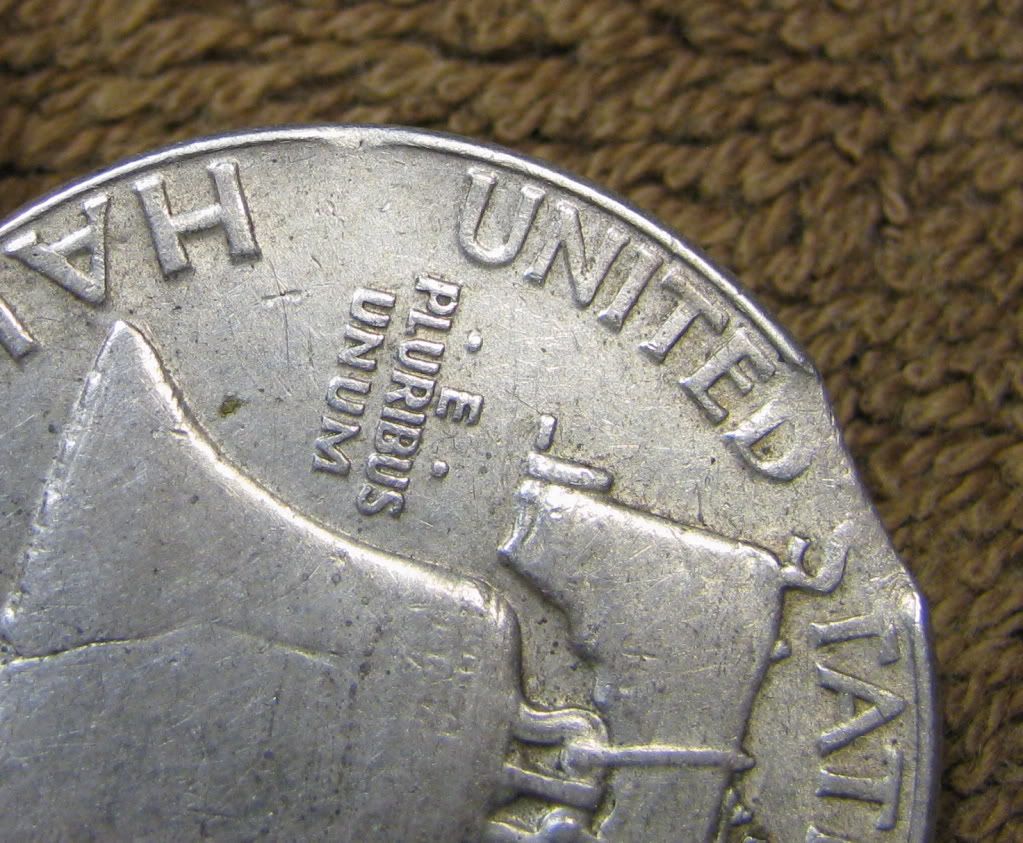
(Close-up of double clipped 1963D Franklin)
Between blanking and striking several steps occur, which may include (based on the metal, era, mint, and intended product) annealing, washing, polishing, and rimming. It is this last which is of interest in the incomplete planchet error. To rim a blank, the blank is fed into the upset mill which contains a specially shaped groove. Placing pressure on both sides of the coin pushes and raises the rims – the same idea is used to “spoon” a coin. However, on an incomplete planchet, the coin is not round. Pressure cannot be properly applied at the missing area – which means the rim directly opposite is also not formed properly. This is known as the “Blakesley Effect,” named after the numismatist who first studied the phenomenon. After upsetting, the planchet travels to the coining room and is struck.
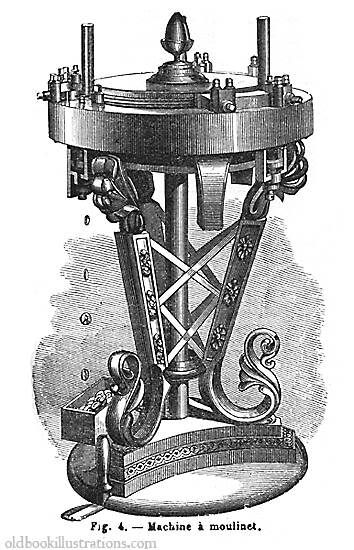
(Picture of an old upset mill, taken from the Dictionnaire encyclopédique Trousset, also known as the Trousset encyclopedia, Paris, 1886 – 1891, found on oldbookillustrations.com)
Incomplete planchet errors, like all coins with some value, are often faked and counterfeited. It is probably the most commonly counterfeited error, because it is the easiest to approximate and one of the most recognizable. The most common method of forging a clip is to simply take a punch from a tool and die shop and cut out a curved crescent from the coin. A straight clip is faked by taking a file and grinding off a portion of the edge of the coin. However, the clip is very difficult to properly counterfeit, and there are several tools in the numismatist’s arsenal which will help prove whether or not it is genuine. These characteristics are difficult to forge.
The first and easiest is the Blakesley effect. The Blakesley effect is a sure sign that the clip you are examining is genuine, but not all clips possess them. A very strong strike will sometimes raise the rim and hide the effect. The size of the clip does not matter in producing the Blakesley effect – even very minor clips display the effect. I have a 1954S with a minute clip, but which still exhibits the characteristic weakness of the rim opposite.
I have displayed two coins below: one showing the Blakesley effect very well, the other not showing it. The first, a 1963D circulated Franklin with a nice clip, shows a very strong Blakesley effect directly opposite the clip. Notice the weakness in TY of “Liberty” (on the obverse) and LLAR of “Dollar” (on the reverse) and how the rim gradually fades out. This gradual fading is key to the Blakesley effect – it will not be an abrupt transition. I have not yet seen a fake incomplete planchet error with a convincing attempt at the Blakesley effect (indeed, I’ve only seen one fake where it was even attempted). The second coin shown below is a very attractively toned 1963 clipped Franklin which does not show the Blakesley effect. Remember, a strong strike can counteract the weakness of the rims, especially when the clip is smaller.

(A nicely clipped 1963D Franklin showing the Blakesley effect. This is the same coin shown in close-up above, highlighting the double clip.)
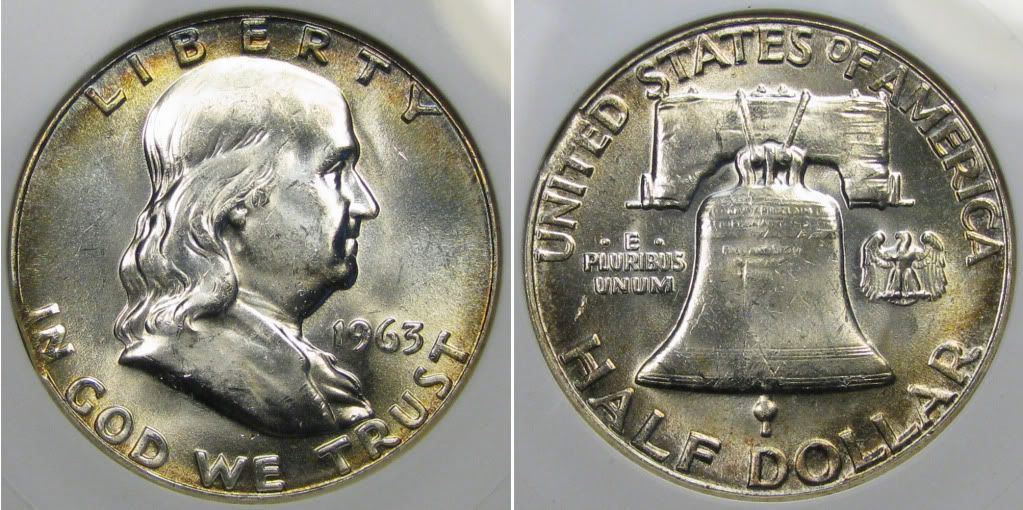
(A well struck, and nicely toned, 1963 clipped Franklin which does not show the Blakesley effect)
The next characteristic of the clip is often hard to see if the coin is slabbed. The action of the punch and cutter punching blanks from the strips creates a characteristic shearing effect on the edge of the coin. The edge of the clip will not be smooth, it will be sheared. The EdgeView holder has the advantage of being able to view the edge, but getting the appropriate angle for accurate view of this might be difficult. This also only applies to curved clips, of course. The sheared edge is the easiest aspect of a clip to properly fake – because the same shearing action is used to cut the coin when making a fake.
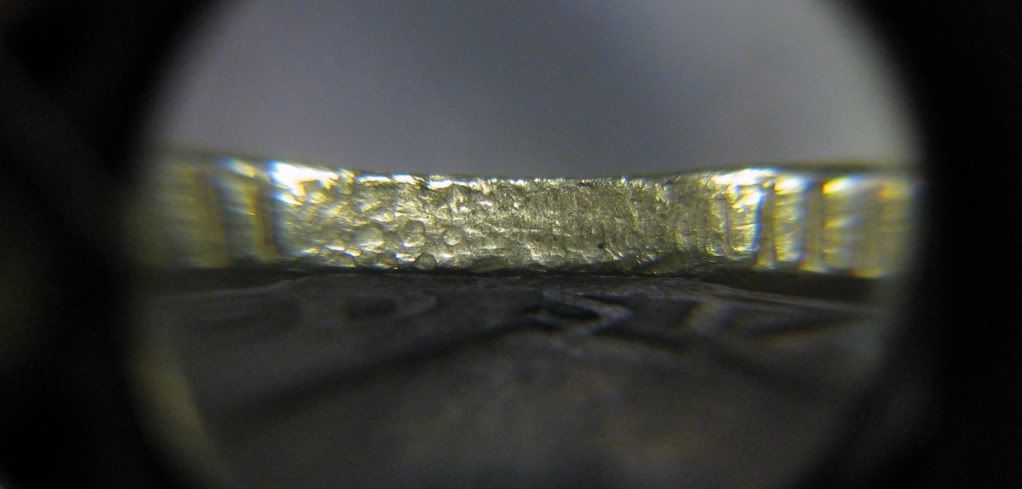
(The sheared edge of a genuine clip)
Because a clip represents an area of missing metal on a planchet, when the coin is struck the metal will flow to fill the missing area. This is why very small clips will appear like none of the coin is missing. Weighing the coin will show a slight amount gone, and an examination of the rims will show the dovetailing which is always present. Notice in the close-ups which follow how the rims always taper off towards the clip. This distinct look is characteristic of a genuine clip, and only by examining several incomplete planchets can you get a feel for how it is supposed to look.
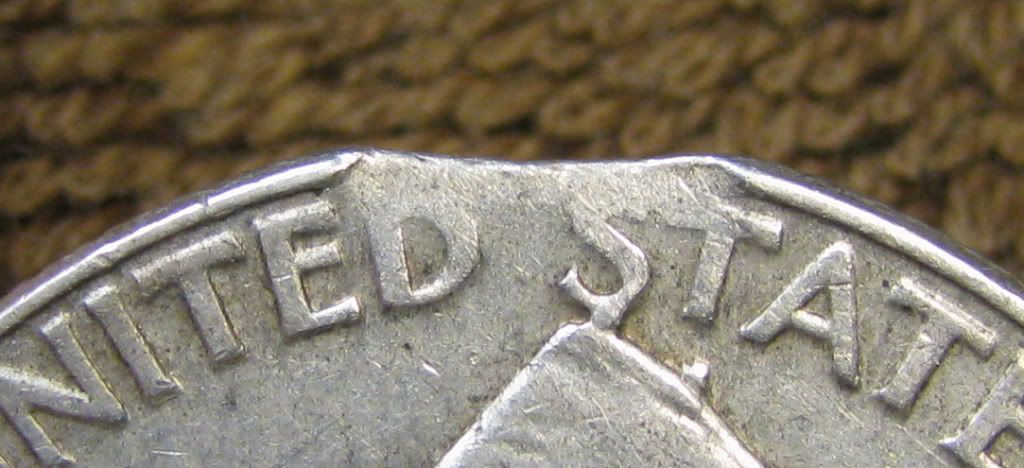
(Close-up of the clipped area of the 1963D Franklin, showing the tapered rims to great effect)
The incomplete planchet will cause elements near the clip to become distorted as the metal flows towards the missing area. Again, the elements will seem to fade out towards the clip, in a distinct and characteristic fashion. Again, looking at several genuine examples will serve to illustrate and teach much better than any description I can provide.
As metal flows towards the clip, you will often see strong flow lines in the area. Straight clips, depending on their size and the size of the coin, will sometimes appear bulged outwards because of this flow.

(Close-up of the 1958, showing strong flowlines around “OF”)
Incomplete planchets are rarer on large coins than on smaller ones, and will command a premium. Incomplete planchets are also much rarer on silver coins. By far the most common incomplete planchets are on modern coinage, and can be obtained for less than $10 depending on the type, and magnitude, of the clip. Just for reference, the Franklins shown in this thread are all valued between $35 and $65. Earlier or larger clips will only go up from there.
Jason Poe

 I maybe wrong and will I say, sorry I was wrong
I maybe wrong and will I say, sorry I was wrong
Comment